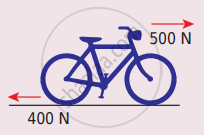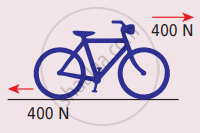Advertisements
Advertisements
प्रश्न
A stone of mass 2 kg is attached to a string of length 1 meter. The string can withstand a maximum tension of 200 N. What is the maximum speed that stone can have during the whirling motion?
उत्तर
Given,
Mass of a stone = 2 kg,
length of a string = 1 m
Maximum tension = 200 N
The force acting on a stone in the whirling motion is centripetal force. Which is provided by tension of the string.
Tmax = Fmax = `(mV_max^2)/r`
200 = `v_max^2` = 100
`v_max^2` = 10 ms-1
APPEARS IN
संबंधित प्रश्न
Choose the correct answer.
Consider following forces: (w) Force due to tension along a string, (x) Normal force given by a surface, (y) Force due to air resistance, and (z) Buoyant force or upthrust given by a fluid.
Which of these are electromagnetic forces?
A mass 2 m moving with some speed is directly approaching another mass m moving with double speed. After some time, they collide with a coefficient of restitution of 0.5. The ratio of their respective speeds after the collision is ______.
A vehicle is moving along the positive x-direction, if a sudden brake is applied, then ______
Two masses m1 and m2 are experiencing the same force where m1 < m2. The ratio of their acceleration `a_1/a_2` is ______
Choose an appropriate free body diagram for the particle experiencing net acceleration along the negative y-direction. (Each arrow mark represents the force acting on the system).
A particle of mass m sliding on the smooth double inclined plane (shown in the figure) will experience ______

Calculate the acceleration of the bicycle of mass 25 kg as shown in Figures 1 and 2.


A wire of length L is hanging from a fixed support. The length changes to L1 and L2 when masses 1 kg and 2 kg are suspended respectively from its free end. Then the value of L is equal to :
A block of mass 40 kg slides over a surface when a mass of 4 kg is suspended through an inextensible massless string passing over a frictionless pulley as shown below. The coefficient of kinetic friction between the surface and block is 0.02. The acceleration of the block is ______.
(Given g = 10 ms-2.)

A steel block of 10 kg rests on a horizontal floor as shown. When three iron cylinders are placed on it as shown, the block and cylinders go down with an acceleration of 0.2 m/s2. The normal reaction R' by the floor if the mass of the iron cylinders is equal and of 20 kg each, is ______.
[take g = 10 m/s2 and µs = 0.2]

